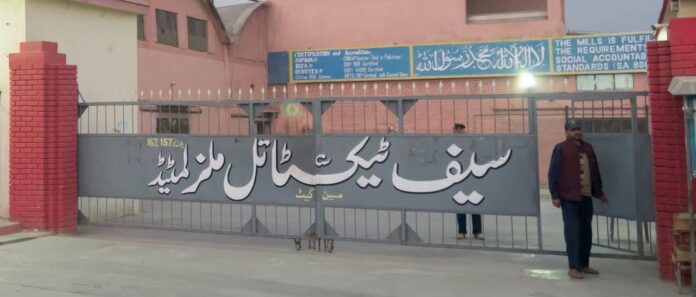What do you do when you’re a company that needs a loan? The obvious answer might be going to a bank and applying for one. But if your company is part of a larger group of companies there might be a simpler option available to you.
Take the case of Saif Textile Mills. The mill is part of the Saif Group and when it needed a loan instead of approaching a bank they went to an entity by the name of Saif Holding Limited — an associated company that is also part of the Saif Group. Saif Holding gave a loan facility of upto Rs 77 crores to Saif Textile Mills in the past. Except the loan wasn’t being given free of consideration or with a payment plan. The loan was a running finance facility and had to be paid back to Saif Holdings with interest. Now the mill feels that it can pay off the past loan with issuing shares in the name of Saif Holding Limited. This is what is known in the finance world as a loan-to-equity swap.
Background to the loan being paid
The loan that was given to Saif Textiles was for working capital requirements. The loan was given till 31st December 2023. For the last few years, the company has been making losses. This creates pressure on its assets and ability to pay back its loan. As the company was suffering losses, the best option for the company was to secure a short term loan from a bank, get extension or restructuring of this debt or to give out equity in exchange.
Saif has announced that they will take the third option.
The company is basically printing shares and giving them to another company as a compensation for the loan that they have been given. But since both companies are part of the same larger group, it shouldn’t be an issue, right? The only problem is that while the two companies are associated they are still entirely separate entities. That means the shareholders of the textile mill are investing in a different company from the shareholders in the holding company. As a result, some shareholders are not pleased with the deal because it means the rights and the holdings of the shareholders are being diluted. But is it as big of a deal as it is being made out to be?
Just how badly has shareholding been diluted?
Saif Textile Mills is a publicly listed company. Up until recently 49.58% of shareholding in the company was held by the Saif Holding Company. As an associated company this isn’t particularly strange. But overall the textile mill is an entirely different entity with its own investors and books.
But as the company is part of the Saif Group, they had secured a running credit facility with Saif Holdings, an associate company, that could go up to Rs. 77 crores given at mark-up at the rate of average local borrowing cost of lender + 0.1% spread. The loan was to be paid off by December 31 2023. From this facility, till date, it has used around Rs. 60 crores. On the 2nd November this year, Saif Textiles communicated to the stock exchange that it was converting the loan of Rs. 60 crores that it had secured from Saif Holding and converting this into equity. It would do so by issuing Saif Holdings an additional 6 crore shares at a par value of Rs. 10 each which would be equal to the loan that had been given to it. The company would give the associate company the shares and the loan would be considered settled.
Now let’s look at this in a little more detail. The company currently has a free float of 50% which means these shares are held by investors who are not associated with the company. Increasing issued shares from 26.4 million to 86.4 million with all of the shares going to the Saif Holding will tilt the bulk of the shareholding towards the associated company. The shareholding of Saif Holding alone will stand at 84% in the new company while the other shareholders will have 16% of the shareholding where earlier they held 50% of the shareholder.
As a result, the book value per share of the shareholders will go from Rs. 151.9 per share as it stands today to Rs. 53.4 per share which can be seen as a destruction of 65% net worth of investors with the single stroke of a pen. Book value is the value of the company after its liabilities are deducted from its assets as declared in their financial statements. The logic is that if the company were to sell off its assets and pay off its creditors, what is the amount that will be available to be distributed to its shareholders.
The January notification
The concern that is being raised in the market regarding this issue of shares is due to the notification which had been sent by the company back in January. The notification was a clarification sent by Saif Textiles denying any rumors circulating in the market that Saif Textile Mills was going to be sold.
This point becomes pertinent as, if the company was going to be shut, the company would have to sell off its assets and pay off its liabilities. The remaining amount would be paid to the shareholders. That means that the book value of Rs. 151.9 per share would be expected by the shareholders as things stood. Shareholders would buy shares of such a company in order to get a payback of Rs 150 after buying the shares at Rs 10 in the market.
According to companies own accounts, Saif Textile Mills has recorded its freehold land in its accounts at Rs. 1 billion while the forced sales value shows that the land is actually worth Rs. 6.6 billion. If this value is used instead of the book value of the asset, the book value of the company actually jumps much further to Rs. 365.6 per share.
The shareholders being disadvantaged
At this stage, it can be seen that a company which was rumored to be being sold is looking to give out shares to the market. On the face of it, it is clear that shareholders are losing out. In the future, if the company does close down, they would end up getting a lower price for their shares. As the number of shares increase, the book value per share falls leading to a decreased payback.
Even if the company feels that the increased interest of the associate company will turn around the fortunes of the company, the company will see depressed earning per share and loss per shares will also fall. At this point it can be seen that shareholders are losing out due to the issue being carried out. If I was an investor, I would feel that in addition to my shareholding being decreased, my stake in the company has decreased and I get a lesser share in the profits of the future aswell.
What can be alternative
An alternative that can be used is a rights issue which could be much more fair to the investors as they would be allowed to subscribe and invest in the company and this would not deplete their shareholding or book value of the company. The additional funds raised could be used by the company to pay off its debt. The equity increase would be funded by an increase in the assets of the company and the shareholders would still own the same percentage of the company that they held before.
Currently the share issue has been sent to the Securities and Exchange Commission of Pakistan (SECP) which has to approve the resolution being allowed to be passed.
So where does it stand?
At initial glance it doesn’t look too good. Here we have shareholders watching their shareholding diluted and the value of their shares drop drastically. But could this be a case of crying wolf? First of all, let us consider the point of view of an investor who currently holds the shares of the company.
Right now, the shares are being traded at Rs. 9.35 per share. This is the most a buyer is willing to pay for my share. In case I feel the company is going to disadvantage me, I can sell my shares for this price. It might seem like I am selling it for a low price but the fact is that Saif Holdings is going to buy the same shares at a higher price of Rs. 10 compared to me. The loan is not being paid off in the amount of pennies per say.
Secondly, the book value has been highlighted in many places. It is acceptable that book value is seen to be a good proxy for the actual price for the shares, however, it is not the value at which the company should be valued at. The book value is just a value that is being associated with the assets of a company. The real intrinsic value can only be calculated once the company stops operating and all of its assets are sold. As this company is still operating, no real value can be attached to future earnings, revenues and profitability of the company. The book values do not account for the future operations of the company and that caveat needs to be made here. Relying on just the book value is problematic as it is being seen in isolation.
In addition to that, the transaction has been classified as a “share issue other than a rights issue” which means that this is intentionally designed as not being a rights issue. The purpose is not to provide additional shares to the current shareholders or to just the sponsors or associates of the company. This is being used to pay off a debt of an associate company which is seen as a loan-to-equity swap. This is being done to reduce the burden of loan on the company which is beneficial to the shareholders as it decreases the interest payments in the future. This tool is used extensively in the corporate landscape of Pakistan.
Now let’s get the SECP involved in this as well. In addition to getting approval from the SECP for the issuance of shares otherwise than right issue, the company needs to “get approval of shareholders through a special resolution for further issue of shares otherwise than rights passed by a majority of not less than three-fourths of such members entitled to vote, as are present in person or by proxy at the general meeting.” This means that Saif Holdings has to get an additional 25% from the free float or minority shareholders in order to get this resolution approved before even being considered by the SECP. The minority shareholders have the power to stop such a move if they feel they are being taken advantage of.
The problem to the solution
It might still be worth looking into just exactly what is being suggested, which is that a rights issue should be carried out. A right issue is a mechanism in which the company asks its current shareholders to subscribe for additional shares. The ones who want to subscribe, pay an additional amount to subscribe for the shares. The ones who do not want to subscribe, can waste these rights. The right shares are also traded in the stock exchange which means an associate company like Saif Holdings can buy these rights from investors willing to sell in the market.
The investors who subscribe, retain their shareholding percentage in the company. The ones who sell their rights, see their shareholding fall. The ones who buy the rights in the market get to increase their shareholding. The funds that are raised by the rights issue go to the company which can then use these funds to pay off their debts.
The problem with this solution is that it is a roundabout way of doing something simple that can be done with a loan-to-equity swap as well. The company first collects the funds from Saif Holdings and then gives it back to Saif Holdings to pay off its debt.
Another problem with this is that the company cannot guarantee that, even after a right issue, the shareholding will stay the same. The investors who do not want to invest more funds in the company will see their shareholding decrease so to expect shareholding percent to stay the same is delusional.
Lastly, just like share price falls after dividend or bonus is announced, a right share also leads to a decrease in the market price if additional shares are issued at a discount from the market price. In this case, this would have taken place as well. By issuing shares through a loan-to-equity swap, the share price remains the same.
It is good to see that there are hawks sitting in the market who have a keen eye and interest to keep on a look out for injustices and abuses being carried out by the corporate sector in the country. However, in this case, they are seeing an abuse which quite clearly does not exist. On to the next one I presume.
Is there a technical loophole in the laws?
While this issue of shares can be protected against due to the high amount of free float held by the market, this does highlight a case where shareholders will see the carpet being pulled from under their feet. And they would not be able to do anything about it.
This is a special case where the company has 50 percent shareholding held by investors other than insiders of the company. Due to this, shareholders could and should join together in order to stop any abuse from being carried out. What about cases where less than 25 percent is held by other or minority shareholders?
In such a case, the share issue will pass the threshold set by SECP, have the backing of the shareholders and the only recours left would be to file a court case against such an alleged abuse.
Companies can even abuse such a law to decrease the shareholding of minority shareholders by taking a loan with the intention of never paying it back, show losses for a few years and then float the idea of a swap. In that case, all these rationale can be used to dilute shareholders value and worth.

























Thank you for this information.I am glad seeing this nice website
The action of Saif Holding is fraudulent and criminal in nature.
If the company want to issue share other than in cash, then it should be at intrinsic value of assets.
Recently dandot cement has issued shares to its sponsors at 22 while market price was 10. I have lodged my complain to SECP and they are taking notice of it. Shame on Saif Textile mills owner. Corrupt company.
Thanks for sharing this info.
Thanks for Sharing